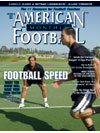AMERICAN FOOTBALL MONTHLY THE #1 RESOURCE FOR FOOTBALL COACHES
Article CategoriesAFM Magazine
|
Winning the War in the TrenchesLSU\'s enhanced techniques for the defensive line.by: Curt Block © More from this issue The first thing LSU D-Line Coach Earl Lane impresses on his guardians of the trenches in pre-season is that their contributions are just as vital to the Tigers success as the guys who change the scoreboard. “What I emphasize to my players right at the outset,” Lane says, “is the importance of the positions they play. When most people use the term ‘skill players’ they’re talking about quarterbacks, running backs and receivers. I want my guys to know we’re skill players as well. Footwork, counts, hand and eye coordination are all part of a skilled player. We have to work to enhance our techniques and ability. What we do is just as important as a quarterback taking snaps or receivers using their hands to catch the ball. We’re all skilled players.” After reviewing the definition of skill, Lane hammers home the significance of attitu....The full article can only be seen by subscribers. Subscribe today!
|
|
|||||||
| HOME |
MAGAZINE |
SUBSCRIBE | ONLINE COLUMNISTS | COACHING VIDEOS |
Copyright 2025, AmericanFootballMonthly.com
All Rights Reserved





